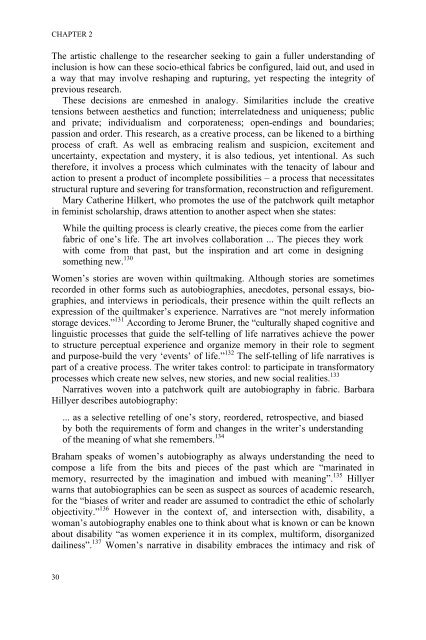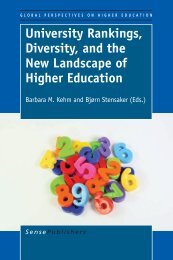Rupturing Concepts of Disability and Inclusion
Rupturing Concepts of Disability and Inclusion
Rupturing Concepts of Disability and Inclusion
Create successful ePaper yourself
Turn your PDF publications into a flip-book with our unique Google optimized e-Paper software.
CHAPTER 2<br />
The artistic challenge to the researcher seeking to gain a fuller underst<strong>and</strong>ing <strong>of</strong><br />
inclusion is how can these socio-ethical fabrics be configured, laid out, <strong>and</strong> used in<br />
a way that may involve reshaping <strong>and</strong> rupturing, yet respecting the integrity <strong>of</strong><br />
previous research.<br />
These decisions are enmeshed in analogy. Similarities include the creative<br />
tensions between aesthetics <strong>and</strong> function; interrelatedness <strong>and</strong> uniqueness; public<br />
<strong>and</strong> private; individualism <strong>and</strong> corporateness; open-endings <strong>and</strong> boundaries;<br />
passion <strong>and</strong> order. This research, as a creative process, can be likened to a birthing<br />
process <strong>of</strong> craft. As well as embracing realism <strong>and</strong> suspicion, excitement <strong>and</strong><br />
uncertainty, expectation <strong>and</strong> mystery, it is also tedious, yet intentional. As such<br />
therefore, it involves a process which culminates with the tenacity <strong>of</strong> labour <strong>and</strong><br />
action to present a product <strong>of</strong> incomplete possibilities – a process that necessitates<br />
structural rupture <strong>and</strong> severing for transformation, reconstruction <strong>and</strong> refigurement.<br />
Mary Catherine Hilkert, who promotes the use <strong>of</strong> the patchwork quilt metaphor<br />
in feminist scholarship, draws attention to another aspect when she states:<br />
30<br />
While the quilting process is clearly creative, the pieces come from the earlier<br />
fabric <strong>of</strong> one’s life. The art involves collaboration ... The pieces they work<br />
with come from that past, but the inspiration <strong>and</strong> art come in designing<br />
something new. 130<br />
Women’s stories are woven within quiltmaking. Although stories are sometimes<br />
recorded in other forms such as autobiographies, anecdotes, personal essays, biographies,<br />
<strong>and</strong> interviews in periodicals, their presence within the quilt reflects an<br />
expression <strong>of</strong> the quiltmaker’s experience. Narratives are “not merely information<br />
storage devices.” 131 According to Jerome Bruner, the “culturally shaped cognitive <strong>and</strong><br />
linguistic processes that guide the self-telling <strong>of</strong> life narratives achieve the power<br />
to structure perceptual experience <strong>and</strong> organize memory in their role to segment<br />
<strong>and</strong> purpose-build the very ‘events’ <strong>of</strong> life.” 132 The self-telling <strong>of</strong> life narratives is<br />
part <strong>of</strong> a creative process. The writer takes control: to participate in transformatory<br />
processes which create new selves, new stories, <strong>and</strong> new social realities. 133<br />
Narratives woven into a patchwork quilt are autobiography in fabric. Barbara<br />
Hillyer describes autobiography:<br />
... as a selective retelling <strong>of</strong> one’s story, reordered, retrospective, <strong>and</strong> biased<br />
by both the requirements <strong>of</strong> form <strong>and</strong> changes in the writer’s underst<strong>and</strong>ing<br />
<strong>of</strong> the meaning <strong>of</strong> what she remembers. 134<br />
Braham speaks <strong>of</strong> women’s autobiography as always underst<strong>and</strong>ing the need to<br />
compose a life from the bits <strong>and</strong> pieces <strong>of</strong> the past which are “marinated in<br />
memory, resurrected by the imagination <strong>and</strong> imbued with meaning”. 135 Hillyer<br />
warns that autobiographies can be seen as suspect as sources <strong>of</strong> academic research,<br />
for the “biases <strong>of</strong> writer <strong>and</strong> reader are assumed to contradict the ethic <strong>of</strong> scholarly<br />
objectivity.” 136 However in the context <strong>of</strong>, <strong>and</strong> intersection with, disability, a<br />
woman’s autobiography enables one to think about what is known or can be known<br />
about disability “as women experience it in its complex, multiform, disorganized<br />
dailiness”. 137 Women’s narrative in disability embraces the intimacy <strong>and</strong> risk <strong>of</strong>














